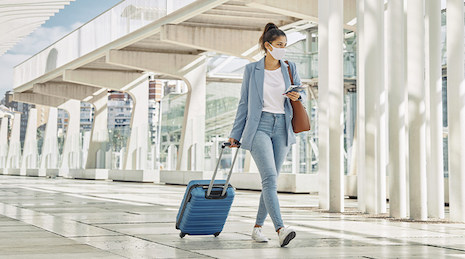The strength of China’s recovery helped the luxury global luxury market return to growth in the first quarter of 2021, but the industry’s overall outlook remains uncertain.
The findings in “Bain & Company Luxury Study 2021 Spring Update” composed in conjunction with Italian luxury organization Fondazione Altagamma, saw several trends, including the United States market acting as an unexpected contributor in luxury’s recovery. The report claims that the outlook for the remainder of 2021 is still uncertain and identifies two possible scenarios for how the market may continue to recover.
"It's clear that consumers still want to buy luxury goods, and this, along with the brands' ability to adapt and innovate, is driving a return to growth in the market," said Claudia D'Arpizio, a Bain & Company partner and lead author of the study, in a statement.
Considering all possibilities
The report cites that the luxury industry returned to growth in the first quarter of 2021 with a 0 to 1 percent increase versus 2019, which the industry views as the last comparable year.
China continued to be the ultimate driving force in the recovery of luxury, with continued domestic spending on luxury. The U.S. market unexpectedly delivered a strong performance, with consumer confidence, stimulus payments and the COVID-19 vaccination rollout leading more Americans to shop.
 Much of Europe still has travel restrictions in place amid rising coronavirus cases. Image credit: Italy Ministry of Health
Much of Europe still has travel restrictions in place amid rising coronavirus cases. Image credit: Italy Ministry of Health
Luxury recovery continues to stall in Europe as the region experiences fallout from a slower vaccination rollout and lack of tourism.
The report outlines two possible scenarios for the market rebound in 2021.
The first scenario, with a likelihood of 30 percent, forecasts that the recovery path will continue throughout 2021, winning back the 2019 market level. This outcome anticipates the market reaching 280-295 billion euros, or $340-359 billion at current exchange, this year.
The second scenario, with a likelihood of 70 percent, anticipates full year growth being stifled by slower domestic luxury purchases and limited intra-regional tourism. In this scenario, the full recovery to the 2019 market level would be expected only in 2022 and the market would reach 250-265 billion euros, or 304-322 billion at current exchange, this year.
 COVID-19 has reshaped luxury retail with ecommerce and omnichannel playing a key role. Image credit: Neiman Marcus
COVID-19 has reshaped luxury retail with ecommerce and omnichannel playing a key role. Image credit: Neiman Marcus
Several trends are cited in the report, including growth of ecommerce, which could lead to new clients buying luxury online for the first time. Bain estimates that 85 percent of luxury purchases were digitally influenced in 2021.
Other trends include a growing emphasis on the next generation of luxury spenders in the United States, as well the importance of brands implementing a “human touch,” reflecting a brand’s ability to go the extra mile for their consumers, further increasing a consumer’s likelihood to stay loyal to that brand.
The secondhand market and circular fashion continue to be trendy, with Bain estimating the second market for luxury to be worth 28 billion euros, or $34 billion at current exchange, this year. This is an increase from the secondhand market’s worth of 26 billion euros, or $32 billion at current exchange, in 2019.
What’s to come, what will remain
Bain’s spring update identifies new trends in luxury shopping that once seemed innovative and now seem absolutely essential.
Trends like circularity are attracting consumers in new markets and more brands are progressively forming collaborations or offerings to give items a second life.
According to a study by Boston Consulting Group (BCG) sponsored by Vestiaire Collective, the global secondhand market will likely grow 15 to 20 percent over the next five years. The thriving pre-owned market encourages hopes of consumers to own fewer, higher-quality items, to reduce overconsumption and to take better care of what they own (see story).
Online marketplaces are progressing at a rapid pace, and many are actively considering how to reach new audiences. When it comes to keeping consumers, CX is crucial.
During a virtual session on March 18 at the Vogue Business and TikTok inaugural Technology Forum, Lacey Maguire, trends editor for Vogue Business spoke with leaders of four online marketplaces about business models, reaching Gen Z and how to keep their businesses moving forward.
Throughout the session, marketplace leaders reverberated the point of prioritizing the consumer. Marketplaces are aiming to land consumers and to keep them coming back by offering unique experiences and fostering loyalty (see story).
"Brands have been forced to rip up the playbook and innovate rapidly in light of the crisis," said Bain & Company partner and report co-author Federica Levato, in a statement. "As life hopefully begins to return to normal, customers are expecting a tech-enabled human relationship with brands.
“Winners will need to stay closely in touch with the key trends shaping the new normal lifestyle – all while remaining differentiated and creating a narrative that is true to their own culture,” she said.
{"ct":"4cUG7ddVrPPopWiMQ\/YYyAbGIMxsLJQ8VgSOIC5yU7oIssvo1vsqr+ANFNbrGkvNhJYx0bnvbzkpGqaiipJsa8TE2NYQMhRj2oFIsqpgkt3otx1PH5fzxPSLADNyMrfiVW4+5G9pWBPpReM7iHrpeUW+cxp6lWqvly8AIaY9B1QT9OmtSnszzyF7\/XL+3UqJBjKLtaBqw11yCy6Nv1kuO\/m3VPNj+aL8XNVDHYoRLm9icx+R0qezDAAiYRRoaAeibCeEDyl2g+FJljdOFGnglXWtXOEdA7FyMcSqt7M0Cd0J5wazZL38WOW16B8r0Q5MiXxloRlE5kGgohO5QDjLcWxwVzKKRrA89dPGpmhI0vnQqL6Lbv9Z4KXrQv19zb0e4DeO7zO+EjdNMCeeZvITgq6MwCnl93157KZfDFJPf93lzHRhxs0BaUTLs\/NwNP+r9SyFYDRlbN7R8LCLXKgRb40c7xhkwm570dKJz3klBlJ6s6SiVAD9tEUQQUWTYOmI5j86txcbYu0fZ8ZtKLUlFChxJ3rAixi2nrRPWaHChGUqUKQ1J0sIwlxsYoT9UnMPrxwrnywks8ViG2VcswPKJILXpqcqCPsKtLNQPcTg5MbG4P3UN7VzNpbHqn2pq7DBibO2BaJyFFol0WoGCBPtXbJH3qvRrso8G1KPClFa41UnDtoSRqtL5X8nDdM0Y1ZPSZTA\/9EewANdyjdV78D4KSE1AVYtQePuF1qpQJhChZELHBGXFxFkd642jIsqwRn6Kc4IaoToV1vSVpnrX2fYzyeOvhkOW4fNkuBqfBmB81zTlpW7rnREuER9ZjF3y2iyRbWyIjjpRFC06WmMU6MLO9UqTC\/utK1I\/Lj5kh9fVmBWa635fyXLioTNsPlWoTOX9lb6rpWPxX52gIo8DdJNaqJF8z1n9iMX\/w\/OaEwU17jiOna96s9laV2suKe84pYJXt5liGMFJwwWimgJw7KgFNJWrbk\/K+U9zwmGipjnjJQqViAij46+FOh+d3Tua75FiLMjLAu6BZnO7w6b0pRhum4Oz+pZ9hV40UgZ0cvMDGJd\/e8SY\/1EsApZdmv3c9sD\/jaw3WDF\/S1N5RcZMJR08EuncJIe6DBB9tTfH8lgdmFeS2SBlHwtE2ObO6rROJGwBRZ6JhPM0JXPtZOmf4boXr05kd67GaUnFWgBt1GbKH271sRRDT+kpvZXRvlmGPZe6GQoF5VGqMCFOW2b3iUp3DVZ8eSWirgoz0ZVSpDTk9e2ez67KHn0wpk4JYjOq5gP1wQR9iQe2JIcVnf0R\/FZxPMrs6f7fIHIzjGkB\/tByXHgeSlFGUIQv0uQKWOIp3K9uwdGgN35bndHPtjiMTNdX7A\/LUEPaY46dbg1MFwtzfz9akbNJbDFwke1HOUr5t1pVYMV8y3MYfxWAQhp6Y9Ms+cjvf2qCsqLY+NrQNuxa06d8CVav2wMxkjdhWN2qYDdy6EC6NwSDBLiR2\/YrRFRiTO4Mx9s+m8b6PVdheLhY5akIrfTgs66x5U5g4V+zBOZPjHq6BPirCpKBbFSSZ4izvAKBGZMI8yDgeHk8sHnrWtG44onPvlHe6MbFxFlR7co7H4tHw9Sszv0ZmmAWOmAg\/743I78w0s+KeIZfIzVqGONiGzTm2GYGThDaIppn8N27qhhrwBO3feXKlgrQH9Sxlvy5kVYZoRKHSo0AZ3r7GvHUNwYmlCQssKSiULGf+cP1uaNpI7Q1MUQFh020GbA\/8AhpMc36Mko1\/O3pJEV1lh0EeE743YclfzENU1bOA7K5ES3uy\/ezGgGgym4KmdS22zqB13yj\/l0IZBApJ36CrUCuaCgBnHIBlol\/zz\/zKNXI4BfQ0klN6L+DyAAqgwFzo4rwPSa+TfAdHWKcxE+PuuHEjbiI9FDLcegjZqhe8Fjny+2qbJo6owg8F4HSc19hyg7dzGnOSeUkOquGxn1Ul+z0v\/lDFpAX3JGaZIO8fNedgTFYHlHFDjKLKU6SnxXuHgcz3Up9NvoS1Ev89XXxsGxCIb7WdGxr+IQUsO+4\/We0YgB4gd1ebkh38xG7EXCmbHLWw\/7JOO5PXPJzkbBKit+k1aOqpYJosWhPcWTFVebzv0kGgaxoQJxyDL771eDSlNeCmot1wZF8pHOxZvZ6RTX3CqDxxct4YLGQ8JG3NecRNs5PTDEWFfPxBUmAExPKVZriZwv7J+BnkGTXjyXqrqh1AQ3vTknxqzMoqdS1AuKx6jmU9BjCEydwuG2LlxrDKYkZIpVAhJqFSU5oFnzYu8g6pvAexhBlEEyGE1En\/az5zeEfq3QyS25jhxSRDYKgGQ61AqfTIO2+b8qyf3prLwbeiBze0OJlXh75ydGjIKV0fD6\/ygUeya\/dGAwckx3zaufl1nIxaCG1b9cleE3+kSAM4mEvU4D6JwRH+3F15WIja+fli3UGUOzJCcBtr6QNtMpzFiBAFg3EkAHsXO0lB9nDenVgItjgV\/kRmEf37LLfg5hCALM4UICIOjNOYHvk0S4iJCpwcM31MdYctNnX3TD2Ohak32\/BOP5gnw4ucxTVjzqHxZ8aUEji3omJnu1Cl7WS0nDEpoSMqqrtEB0agdX+gLLetUB+vcg\/eJeiNAS8k8syS2hABzTMtHDbfAIeQ7x3gGy0VSWCVrlIqF7LvXVsrlZlJ\/d4O\/xoaFD0MQH1GExuXH7EqUQnmkO7kTSMBBEy4zSo5\/XmNtG\/WfR49RRHhyZwkyU7R9DoQ97LGE4cacXDN\/sawX2eVOu\/dozGP+N9HPGI7aWlqr0XJCHLYqvYiyYnCAQQBjTYMqBPASXB\/sw\/\/IvWsqDiYtpeAxi55\/Z0mKqEAw\/ddtG56WE0VwhM0mjHuHo1DLKFunYDFyr+dV76OkOtkgK0AfNCYW6LsRlszjdZF+S+2ouluyfeI4lsb6JdL0JrrwQBGYCwo4YCBTUeGAFgchHldN10\/EgbDLjIiq7cSSrP7EbMDQfo9vhE9sLCKeSxrs3kQLf7E\/sw7zoRkle0wwxFXNg62NzQyAXMbjN3z8IW4f+LSauCqewLBQ6BDmE5Olq1lYngTaPeNa4fuxJFQkWOusU9kMbCn7C3hsiOwuo27o5uMD9lTCd0gbbxZUar0Pks95fCf1wUOG1ZnVHmDWWR+Tz5GaZ4hb705JrQxk0+W5ln3pLmN+I4NyKmTgic4dvPHx9fy5X4TbW+BphY2jtCZvFh9QO6diFyeUFaZl0lbNgs5ojk8K2hz2PuZiycCZoohW3co96gvxbCtPuRWHpL7T1CX9YHcfoo4VIXEGwZF1wFL36Ez6NcSpsCJY728QaQaXzrjGV3I4v7Pwcoo9iGZn9eNKUeKGGuRQlYBQbbIzCMfCENysbXkFaiqV8idu+PwUufEk6J01ydQeSw7YXoIRblddJcNZFUxOwFyuivf8lS0gdZEWyzprvun5urz29dTAyDO92sbUNPg6YWrv4fur\/QvKzPlitKBxAYb9bpnU3mMf6m8bnn1RL9A9v\/E1ch0VxiNoLO3KJJNnDo3Dok90XZ89kZkUJrGDoAsYs\/cxSAeRLhDeGnEZi6eAwaE4EfCBpNXN\/BUAZCAiMq7gFf3167N8fLQTJZH4t6H7lnmZYrOIR1MK3n4pa\/7unFy7y\/azfI6JezevmUAd9DpjXjM3K+K5NDLq1+TZN93X6oStqpLWRCziwuWDICM22mdYmLCQyowPNUKz3VDP0bGaxJV0EDdgQqA7ot2Oad\/0kchC5X0TkkIKC0lng8uq5\/8BN8m4umjADv+nSQquB4XE3bg+Ef\/JePPuQH\/Gj5cKFgzQG\/tvRnDmXuo7zJ887DNcbmgih5S4towPoCbGnzUe7+LyKXeSRqcPEsMODsp1SlTv+vjU4tQJMcekcdTyMRkTHD4fbW9cvyawpNLNN2Qavi\/EtTYcvVG4dWpu2g6As0bZjTuG4LZjqQCTcghVEHCnyEPk9jgpWdDwB7irU\/0T3+L9ORNj\/IjhIEFg9FeAg02e7EfD7wvg7Zw8Wou1g9s7BBrADmYYSmgGk7TUiuINWTeprior8fZh9frxRu4xTa+Hk\/03BMg26gB6hXgPTxkPTedBZUQqBpgj\/cm1tsY6V0YEiG+HiSZuIct9vtQBtS96jsIDUj1d+n7CpAmZWvIo9Im9Lv8zzanfKvAWP5YuDysxedClXZ1vD4dv8qN7PYZge7PD0Q9QjB+W1BgykoA3moZwtKSRc0WpxSQx4rlxEYC9nsDNmsnQI6Ssn8cCxRk7mTkh0xZ48Jw2P1fqMZ8m0rAo1wlUfm6SB7fKSM35+NDAnglijH2Tjj6Y+CVNLfdTZjM\/lu5CgEHgQZ\/y1B9MQWw06aocCq6TRG9I8f96LMBTWXYl46SQfN5qVHXgjOLloouq\/Vp8jcfAPlHcHxOC+1xfJsKhmQ5+PD03X2vCXBVOyG9Mha1DsQfZUrRAu0XvKGCgwWbldVNqHLOG3GCpvC27kQobQWdwcdYknu4zRPSb89BCGav9L7R+fsSlKkw4lC23gB9FQIWlo2CpevPwIDh8ysj62Kf4tK0qYNKY\/vQNnwGIK+QFlMuI+OAKxBFeCw7JCd4xJP7aldSanFew1ayOjsQnfJ9YNpTlgGQ\/EfSq+e3xCpDq2ZQIP7Keu88i0xH9fYl1VBenLI6JBkilygdrzxk3crGHsbYidIfkDfYEd0KfaEpttAfDxPSg1Dtv9u4dVgF9YG7Baui7qk1gpk3ZmzXAhxP2FlkZqVFryOagTgBhRKIdcCOezUKwFYdNzxlHY9qAJPmZA+b6\/1mCoea297vKloyKnMTP2OAmtMg0aqxWrZVf5gfw1rWpb9bVpgQe5fJDR6nyypZpm9xn7R98oV\/FUVF\/mM\/i2rnf4ErM5NAOVs7ClzaAX5KPlKwX57+csAPVxM65LT7+hI7dcBArVNSlsOskJIUSH6cCDQzcIVorXvCQ6errkx3LjRYLryUvzgEHsJXiDgiUUokkDN4Wc4OqNgClJEwhObyJL7wArzVRlno8bjNqFsFBeD1nzb3qyHGPbe0sN24pk2goHgiLbxTllAUvcBKOo2xVZs4UR021AX42Qh8\/VdAO0VdrT+yqvUTY4ose1zt+WOCW37QjUwCRM2xA8b0BmGIVyIVgUnM3mQeLcDuGbFG+SXXRytIvRI4XAk\/jRTs8b4ZVMY731KEYJoXNe6X7aCICdD2jhZewkGTT3bS9hWlfhGEc5wg7WQSw3JQuac\/9QUzPRXJOJ\/v5fJ8YmUXj9xfzx89VfQjN2bBTQwVZEdgvbfzjCvbMRi\/sujPWeGWgpLauPtYK6dGU0jjqCtlYVgWBT0WSxwVeTQKvuyDpxyBMX24pPJJ\/q4+zE7plfsqqIJrGPYTJqKEQz02uaG8E4g8IOcrVPJmICOxDbOMDGOw5wT6FZPFnqmJZkUzviyKnqRnGMI3HOXqdnbiME2\/xa0KZaj\/oQkloKVjI+ZnTcf7RnXBW3OAm45ukUv2cbdT0gChU6C+Th3jr67fVH9ntmBgpwe3fLt0l3uPOkuFcZzHKfF6mDVmUbeqhyqgFJ\/nG3q5ZnLDvOHmdGiQ7rFeOrsm+Pgi9d\/b+huo98jJpKZrJIzHovQWEzgHY9AuSgT+A6Mpwwq5HkOXuYwBcjMmIfHAuzMCCfUZFfO\/XExQzoZaFTnuFA\/xmc0csgaqOOVuoXQtGeHTG6PYnBzvyLWwxw2sYDvNegw6I\/hgym0yIWm6Yl1izIY9vR8Ed7oi2X46GqfCLBmW+yuSgqk+79x4jPPHJqeJ+G1wAasw91\/uuo50pHy1ND8463SXtX++pEQj+hFPeY3KujiK2\/CpbeKRjADMI7CwyAL3fd3Td10EqvWVWRafhwE+ct8l5jRHP5iJaGUmlfX1EfrJoZueOmUzT4RIgBJkEGif16Ox1+6VOym\/0xbNpIgOqhFZ932SkZgDfxtQHIq8sGKp+WGewfib\/pImSk1nz\/GJ2smmS+399oy3+7KYIQJSA2WaOFXpWrHer06p87+d+pAL487+iB677iCazvxBdFBZsjaoencKQDLK5XlH0W2SEFOkenpBa6xq0+he6K44jvs0C96Kc3fbsmTMqGpCNshj2IbngY4Y2CG+ibNRucc9dr5BCRvItgkxP83XPEmIaA\/ZYTsXJpjfcET2xMP\/per3qskPElMdFpPPhCPVqksZAUn74ZcaDed6uNASQDEjuD6Xv2dmKJuNI0Ky2j9SVmeao2jJOffNQQQRRezI2ZnDLMfaBnOebXmgNM37aNGYj2zpC1kWILqipycnLxhwDtL9emicH5jLIFiM669QMWqzge0PMvZGeTAC9FdwjDNz9gk7L8+BM3XkBwHuRFM3rYmDhxdbBzVJfal6X0MHJjiD9v4FsD\/G9PsSdViwyehVRFQrogL6JSJ5f6frENdS698k8QKFKeWzcoAyn54oHQmbOfUBPPZcQnKGBZkwpz7vJLj5yHn24z+kjJBp4u8rb7z4pJq5uqL1qtHE5SSPE04pozAOViO\/PBCqZbb3AMYFJFradmKKi4BidcNnetF1oXP6ElZz1lzeYPACD557Go4mFX\/TDVfgSDMXosPINr5p0v8eUWTc+r7ahxwdcxHv+Ez4Y58BXlgqO0wq3LVsiXYjFB121L\/K0s5Y6QRHk96XAW1Iy93TLd\/vAkIXyYAzTgVFYud0DmaEGSXi\/r+cp5TaTpGMs+XQFZD0sxgxLxb7a1POnepKHibKgc84F95RsbMr0DIKwxiwGzQhThPpiS4t2Pi\/wqoCiHa55sDxGUOqlPE+LKeD5YpWjYoKjocxu\/lCWdSZUOw3y0yjtPnnT9bUE03aFaA8QS0imu\/nIFOEGvkbigX+zTDx3OF+0z4iZR2KTWtSIIey2Uhgh8xf\/kIl6JX9b\/xmMKXxG\/Ty9OWRlOpGFdArIPTaJTaXWHBH\/CQ5CfVnGn1eIW6sRZw+Y5Kqkg8QxIh\/dY624orif11FuRGTwsMhBBU\/iaic3PwnmS9Kv3y9krYusq5GZ5XRSIbnOo6+xNf6R6edYqalc24Gz\/FVYjQPznXbeaqrJ\/abRqfso\/R2rflaKHQhY9780O6HFioBK0LbQ4gjAluTCaotVhJYL+uJiIyIJHa9lHEnLIQzU+sDGFRh7hqYr+kH\/rsNnZ4X6d7VngBeWIkIN96GDIFSZ8\/V9DJtzl\/K1W8kE2RO2DbdZVgPgtr7Kejn4imHeUU5hHNkmuKVOhk\/6OonS6xoRng\/pCXPvQeQFv9Sn2Q85OwrQBs+GwTldLuGCdpMpSEUG0RRTdnkL396Z\/irqvjX1jcriMmNz1PwMcawV+KZz8huCwft7DuG4+uUAVW7CzgkNMn7k4EzhMFFzTSLT\/xJxjEL+Iylp7B\/wc8SxGHAWP1rRyzh\/HQ\/pi1TSCsWSHvdQuUVUKE5img6P0gZt1lAYhYJ\/9HvHuVW9w48+SbxMAIdg4xSDsbAwxQXL\/e15GNwvhh5FdVm\/qeppVQhOlxQV2b84l8wGtRqE3hznWzmL9WjS9E\/pTMd7oIAF\/3Qw1zSP9U9lLBtWXBfqRZMi\/hhFatm2QaAbb\/Oi0F7xoZgX0GGb7CwE2kWFxeJyg2mP83Wri88xxWIFIPJTL8RjNk+TrQmldir\/jcP3yvDv7uXTathgeJgCyVgXUEBrMO0LON6ZfKJ\/WmMS1hVLpokBOrtARZkKMfJbaaUCNECwYUUG2RVVZfNGMixJuMlw8Mmp9C\/+f+9G7PX2fHffrBA9m0V0O2bP\/zUWlKUtsND+WFe\/aojiL6E4BWwOTmXJswvp+NOJ4gjTbFcYQlnSyqY0AflWxM5mzpeg7OB2v8fuVMHcJmGaYuIYT\/MMCFpXUOzhlQ88gqBfqEzwdTnnxXTB7TuiqMn6EFlrlWpUWHxDgNt90vDPpYvloS5O+WJUGbJMtGurrYtbtyRJ13Epl\/xRbPHYYOgeLEGp4OTOA3bNOlhebXnjEu\/j9k07th56xVlz9WnscwROf80aiYJ91jcI4arTaBWNKfZ1ac3rCP10S7pgSaA011ZleStc+bOLr0R3JGDvseyzE4zOkwSv4Oz0NxtbYXGuQY9qiH72KPIYqprLVDQefFswpOkqsQZ5XGjN\/YJ6MT661goET\/31alzmg9K7DY9q+DFOJnPZhyRar+PHVXgcrAdIQF6WWe0GoY8XiX\/BS+1TwG+GZah438j\/eWfKfKov4QExZFuvYXNMpH7LFt44YEY8fhPQfnx55izwl+EkL9Zw6\/wXOG\/5tWAo2QlP36xUFDiITvwDuYyeW1YMkJT6\/jSVaiaVPJuvccDVKWMcIIW7CxMg1EoHhtjndGGDZgb8Qd4IH4tRe82f1WWH6envTwVAhONV4rIK\/4ZxNMYID75LV3KHhhs8uiDdsSMCK09mSMk\/+s0rhNoo6HAAe4Rml6vvyP6Y4ii4v+v1HF9wacDLRqCLcn0CncEjHy9wd3naxVWwGtbdQx5Q2U7INg6JfY3NLUJrz03XClyKrpAgsJ0Q06ttqy3uHrb\/XM877Yr64kDjq0jRYFfe4yD4IiMLPxVr7Y5GCAEQcc3gTMzyC72w+4dik9+MYgV3yb+HvB\/1fS1knqkxX+HDQQMZmRDMImBWdaUu98NfPq9wenOiNakepjQWaS8KY3vUpmWriWBLWbtHFaPrkq14dxuu3gW4jW8V\/qL9XKst9d7VAEY+mDrSMAksEUbgzH4vgOtmi5SV3D2U7gFp4uqx0jkI61w8u8H5V\/sfpZQlFuM6XLPE0SpwULjfYmBjurwKJvs4WMycBUzyTB+yn26IvILwdA\/mCTmF\/uyoX1ZYku\/4Vc5D211ONUQpRh\/o5vJ9I\/XOihIPXrH\/CuiEd0IWjoj7MEpbM9KbxTpcCO5xO2Q2o3a9uM\/\/VKLV9lfZnKb1ZdCnNK0qgAQusfrOUVdNO5FLwdCrYt1ZkPAz\/90Ivm93r5QUtGM8Klr\/XPbvoNZu4m4vfNJzetFsLlaCFzK6LjYsOlG5raQVtpb27FcaAJYKrO6Q=","iv":"b2809f1560e9637916e34001f4863a8e","s":"1f39bd32e03a457f"}

 A new report identifies trends in luxury from the first quarter of 2021. Image credit: Shutterstock
A new report identifies trends in luxury from the first quarter of 2021. Image credit: Shutterstock  Much of Europe still has travel restrictions in place amid rising coronavirus cases. Image credit: Italy Ministry of Health
Much of Europe still has travel restrictions in place amid rising coronavirus cases. Image credit: Italy Ministry of Health COVID-19 has reshaped luxury retail with ecommerce and omnichannel playing a key role. Image credit: Neiman Marcus
COVID-19 has reshaped luxury retail with ecommerce and omnichannel playing a key role. Image credit: Neiman Marcus